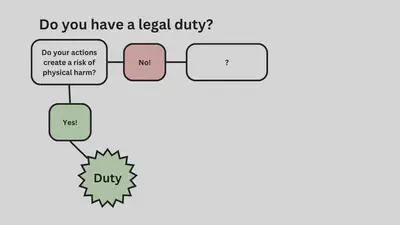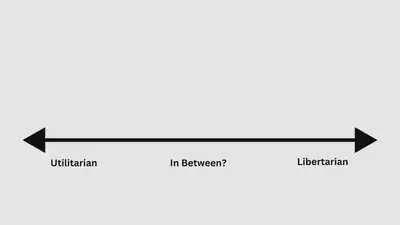No Duty to Rescue or Protect
Proving Negligence

In-Class Exercise: New Variation
Same facts as before, but rewind time to before the trial began.
You are a junior attorney working for a law firm defending Idris Benson. A partner at the firm has asked you to produce a memo addressing three issues:
- Given the facts that we know, what are our best arguments that Benson exercised reasonable care?
- How do we counter the plaintiff’s best arguments that Benson did not exercise reasonable care?
- What facts should we try to learn before trial?
How does a plaintiff normally prove duty and breach?
D was legally obligated to do X.
D failed to do X.
Therefore, D breached their legal duty.
Detailed version
D had a duty (to the plaintiff) to exercise reasonable care under the circumstances.
Reasonable care under the circumstances was X, because of - foreseeability, - reasonable person standard, - custom, - statute, - or hand formula.
D failed to do X, therefore D acted negligently / breached their legal duty to plaintiff.
California Negligence Jury Instruction:
Negligence is the doing of something which a reasonably prudent person would not do, or the failure to do something which a reasonably prudent person would do, under circumstances similar to those shown by the evidence.
It is the failure to use ordinary or reasonable care.
Ordinary or reasonable care is that care which persons of ordinary prudence would use in order to avoid injury to themselves or others under circumstances similar to those shown by the evidence.
Reasonable Person Standard
An objective standard designed to clarify what reasonable care requires.
Exceptions to objective standard: - Physical disability - Children - Expertise
Not exceptions to objective standard - Mental disability - Children engaged in adult activity - Old age & infirmity
Foreseeability
Foreseeability is a flexible concept.
Define any event in general enough terms and it is foreseeable.
Define any event in narrow enough terms and it is unforeseeable.
How to use customs and statutes
Sword for proving negligence Prove two things:
- Custom or statute = reasonable care - Defendant failed to comply with custom or statute -————————————————— Shield for disproving negligence Prove two things:
- Custom or statute = reasonable care - Defendant complied with custom or statute
Negligence per se
- Actor violates a statute that is designed to protect against this type of accident and harm
AND
- the accident victim is within the class of persons the statute is designed to protect.
Hand Formula (BPL)
B = Burden of precautionary measures P = Probability of loss/harm L = Magnitude of loss/harm
IF B < PL AND defendant did not take on B THEN defendant was negligent
IF B > PL AND defendant did not take on B THEN defendant was NOT negligent
Cases for Establishing Reasonable Care
Adams v. Bullock: “The Swinging Wire and Electric Trolley” Braun v. Buffalo General Electric Co.: “Electrocution at a Construction Site” Bethel v. New York City Transit Authority: “Bus Seat Collapse” Baltimore & Ohio Railroad v. Goodman: “Reasonable People and Railroad Crossings” Pokora v. Wabash Railway Co.: “Revisiting Reasonable People and Railroad Crossings” Akins v. Glen Falls: “Baseball Park Injuries” The T.J. Hooper: “Tugboats and Radios” Martin v. Herzog: “The Buggy Without Lights” Tedla v. Ellman: “Walking on the Side of the Highway” Rushink v. Gerstheimer: “Leaving Keys in the Ignition” Trimarco v. Klein: “Broken Shower Door” Robinson v. District of Columbia: “Jaywalking” United States v. Carroll Towing Co., Inc.: “The Hand Formula”
Existence of a Legal Duty

No Duty to Rescue or Protect

Harper v. Herman
“The Boat Owner in Shallow Water”